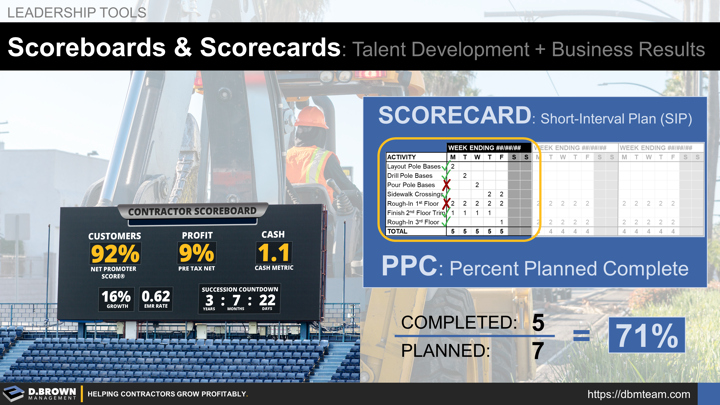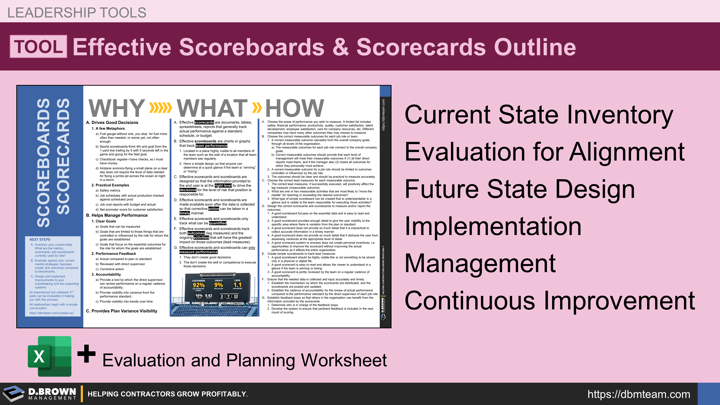There is that old business wisdom that you must do three things: get work, do work, and keep score. Some contractors refer to it as book, burn, and bill. From Peter Drucker in 1954 describing Management by Objectives (MBO) to Sean Covey describing The Four Disciplines of Execution (4DX) in 2012, the basic concept of goal setting and scorekeeping has been part of business and sports for a very long time.
While scorekeeping is important, it is even more important to understand that scorekeeping is only effective when combined with the right strategic choices and supporting management systems. Lack of effective supporting systems is one of the 16 Reasons for Failure of Scoreboards & Scorecards.
"Eighty-five percent of the reasons for failure are deficiencies in the systems and process rather than the employee. The role of management is to change the process rather than badgering individuals to do better." - W. Edwards Deming
With that said, and when used effectively, scorekeeping is incredibly important for both developing talent and improving business results. Scorekeeping enables balanced execution for contractors and allows them to navigate all stages of growth from starting up through sustainability and succession.
Contact us for an outline of Effective Scoreboards and Scorecards.
SCOREBOARDS
In business terms, a "scoreboard" refers to a visual tool used to track, display, and manage the performance of a business against its strategic goals and objectives. Similar to its sports counterpart, which displays scores and game progress, a business scoreboard provides a clear, at-a-glance view of key performance indicators (KPIs), metrics, and other critical data that reflect the company's current performance status.
For a contractor, this may be at the company level, business unit level, and project level as applicable. A simple example of a high-level scoreboard for a contractor might include basics like:
- Customer Satisfaction: Few things are more profitable for contractors than recurring work negotiated with a select group of project owners. Delighted customers are the foundation that recurring service and special project work as well as alternate project delivery methods like CM-at-Risk are built upon.
- Profit (Pretax Net): Targeting consistent performance at 2-3x industry benchmarks because average is just that.
- Cash: Great cash flow is necessary to fund growth and minimize risk. Is your WIP (Work-in-Progress) generating cash or consuming it?
- Safety: Nothing is worth anyone going home in worse shape than they showed up - or worse yet, not going home. Safety metrics say a lot about a contractor's culture. While it is conceptually possible to have a truly great safety culture with horrible quality and productivity, we find that these typically all go together. When we see misalignment between safety, quality, and productivity, it is usually because the focus is on safety compliance which only goes so far.
- Growth: Contractors grow through six predictable stages from starting up through sustainability. Growth for the sake of growth is never good - but "Good Growth" where all metrics are trending in the right direction is an indication of vibrancy in leadership focus, strategy, systems, structure, and talent pipeline.
- Succession: Developing succession readiness at all key levels including the top-spot is foundational for both sustainable growth and risk mitigation.
While this is an example for the whole business, there will be related scoreboards for each functional area of the business including Critical Supporting Operations (CSO) and business units that are market or geography based. Look at your business model and determine the cascading scoreboards for each part of it.
SCORECARDS
A scorecard is much more detailed than a scoreboard though, in general, the sum of the scorecards will materially predict what is on the scoreboard. Scorecards record the performance of an individual or even a single activity such as a time study.
Brad Pitt, Michael Lewis, and Moneyball made the individual player scorecard of sabermetrics known to the general public. Though this was dramatized for the movie, there is a lot that can be learned from these two short clips regarding how contractors recruit (Interview Scorecard) and how they must scale given the talent shortages by focusing on role specialization.
A great place to start with scorecards is at the job role description level. What are the key results you are looking for and what are the leading activities that will get there?
Do the math in your business model as you think about job roles and the balance between specialists and generalists.
Another great place to start is at the project level and your weekly work plans or SIPs (Short-Interval Plans) measuring Percent Planned Complete (PPC) learning and improving each week. Note that higher scores are not always better - and this is a critical aspect of setting targets, scorekeeping, and management. From a talent development perspective, this single scorecard item can form the foundation of your Foreman coaching program.
Going even deeper than the job role is looking at the specific tasks that add value to your customers starting with the high-frequency installation tasks in the field. Once standards are created for these tasks, then you can begin the continuous improvement process (PDCA - Plan > Do > Check > Act).
A valuable tool as part of the "Check" process is a time study. This is literally observing the specific task performed multiple times by different people, and in different conditions. By studying the task step-by-step and developing a scorecard at this level, you can improve the standards and the average performance.
Scoreboards generally focus on lagging measures or outcomes while at the most granular level such as a time study, scorecards focus on measuring the activities that lead to those outcomes - leading measures. See this example of how cash flow is broken down from a high-level lagging measure into the leading activities that will result in improved cash flow.
An experienced but unbiased 3rd party can be invaluable for helping you evaluate the current state of your scorekeeping systems then designing, implementing, and managing improvements including technology integration.
All relationships start with a simple conversation.


